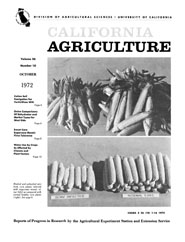


University of California
California Agriculture
|
|||
|
|||

Cover:
Husked and unhusked ears from corn plants infected with sugarcane mosaic virus (left) as compared with normal healthy corn plants.
October 1972
Volume 26, Number 10 News and opinion |
|||
|
University of California, 1301 S. 46th St., Bldg. 478 Richmond, CA
|